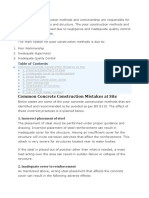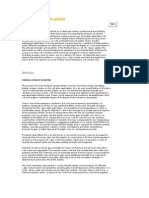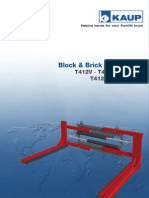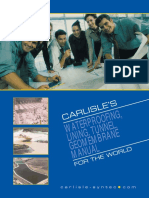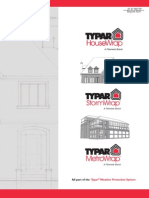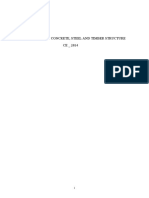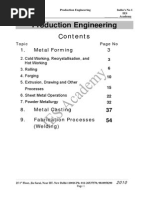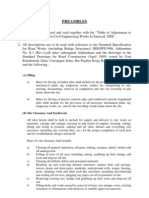0 ratings0% found this document useful (0 votes)
126 viewsCip-02 - Scaling Concrete Surfaces
Cip-02 - Scaling Concrete Surfaces
Uploaded by
Kyaw Zin HeinThe document discusses scaling of concrete surfaces which is the local flaking or peeling of hardened concrete exposed to freezing and thawing. It occurs due to lack of air entrainment, excessive deicing salts, finishing issues or curing defects. The document provides tips to prevent scaling such as using air entrained concrete, proper curing, limiting deicers, and applying sealers or coatings.
Copyright:
© All Rights Reserved
Available Formats
Download as PDF, TXT or read online from Scribd
Cip-02 - Scaling Concrete Surfaces
Cip-02 - Scaling Concrete Surfaces
Uploaded by
Kyaw Zin Hein0 ratings0% found this document useful (0 votes)
126 views2 pagesThe document discusses scaling of concrete surfaces which is the local flaking or peeling of hardened concrete exposed to freezing and thawing. It occurs due to lack of air entrainment, excessive deicing salts, finishing issues or curing defects. The document provides tips to prevent scaling such as using air entrained concrete, proper curing, limiting deicers, and applying sealers or coatings.
Original Title
CIP-02- SCALING CONCRETE SURFACES
Copyright
© © All Rights Reserved
Available Formats
PDF, TXT or read online from Scribd
Share this document
Did you find this document useful?
Is this content inappropriate?
The document discusses scaling of concrete surfaces which is the local flaking or peeling of hardened concrete exposed to freezing and thawing. It occurs due to lack of air entrainment, excessive deicing salts, finishing issues or curing defects. The document provides tips to prevent scaling such as using air entrained concrete, proper curing, limiting deicers, and applying sealers or coatings.
Copyright:
© All Rights Reserved
Available Formats
Download as PDF, TXT or read online from Scribd
Download as pdf or txt
0 ratings0% found this document useful (0 votes)
126 views2 pagesCip-02 - Scaling Concrete Surfaces
Cip-02 - Scaling Concrete Surfaces
Uploaded by
Kyaw Zin HeinThe document discusses scaling of concrete surfaces which is the local flaking or peeling of hardened concrete exposed to freezing and thawing. It occurs due to lack of air entrainment, excessive deicing salts, finishing issues or curing defects. The document provides tips to prevent scaling such as using air entrained concrete, proper curing, limiting deicers, and applying sealers or coatings.
Copyright:
© All Rights Reserved
Available Formats
Download as PDF, TXT or read online from Scribd
Download as pdf or txt
You are on page 1of 2
This document is copyrighted by NRMCA.
Print copies can be
obtained from NRMCA by calling (301) 587-1400 ext. 101 NRMCA
What, Why & How?
Scaling Concrete Surfaces
CONCRETE IN PRACTICE CIP 2
WHAT is Scaling?
Scaling is local flaking or peeling of a finished surface
of hardened concrete as a result of exposure to freez-
ing and thawing. Generally, it starts as localized small
patches which later may merge and extend to expose
large areas. Light scaling does not expose the coarse
aggregate. Moderate scaling exposes the aggregate and
may involve loss of up to 1/8 to 3/8 inch [3 to 10 mm] of
the surface mortar. In severe scaling more surface has
been lost and the aggregate is clearly exposed and
stands out. Scaling concrete surface
Note—Occasionally concrete peels or scales in the absence of freezing
and thawing. This type of scaling is not covered in this CIP. Often this
into the top surface of the slab, a high water-cement
is due to the early use of a steel trowel, over-finishing or finishing ratio and, therefore, a low-strength surface layer
while bleed water is on the surface. (see CIP 20 on Delaminations) is produced. Overworking the surface during
finishing will reduce the air content in the surface
WHY Do Concrete Surfaces Scale? layer, making it susceptible to scaling in freezing
conditions.
Concrete slabs exposed to freezing and thawing in the d. Insufficient curing. This omission often results in a
presence of moisture and/or deicing salts are suscep- weak surface skin, which will scale if it is exposed
tible to scaling. Most scaling is caused by: to freezing and thawing in the presence of moisture
and deicing salts.
a. The use of non-air-entrained concrete or too
little entrained air. Adequate air entrainment is re-
quired for protection against freezing and thawing HOW to Prevent Scaling
damage. However, even air-entrained concrete will
scale if other precautions, as listed below, are not a. Concrete exposed to freezing and thawing cycles
observed. must be air-entrained. Severe exposures require air
contents of 6 to 7 percent in freshly mixed concrete
b. Application of excessive amounts of calcium or made with 3/4-inch [19 mm] or 1-inch [25-mm] ag-
sodium chloride deicing salts on concrete with gregate. In moderate exposures, where deicing salts
inadequate strength, air entrainment, or curing. will not be used, 4 to 6 percent air will be sufficient.
Chemicals such as ammonium sulfate or ammonium Air-entrained concrete of moderate slump (up to 5
nitrate, which are components of most fertilizers, inches [125 mm]) and adequate quality should be
can cause scaling as well as induce severe chemical used. In general, concrete strength of 3500 psi [24
attack on the concrete surface. MPa] for freezing and thawing exposure and 4000
c. Any finishing operation performed while bleed wa- psi [28 MPa] when deicers are used should be ad-
ter is on the surface. If bleed water is worked back equate to prevent scaling.
b. DO NOT use deicing salts, such as calcium or so- manufacturer’s recommendations for application
dium chloride, in the first year after placing the con- procedures and frequency. Another option is a 1:1
crete. Use clean sand for traction. When conditions mixture of boiled linseed oil and mineral spirits ap-
permit, hose off accumulation of salt deposited by plied in two layers. The concrete should be reason-
cars on newly placed driveways and garage slabs. ably dry prior to the application of a sealer. Late
Subsequently, use salt sparingly. Never use ammo- summer is the ideal time for surface treatment. The
nium sulfate or ammonium nitrate as a deicer; these sealer can be sprayed, brushed, or rolled on the sur-
are chemically aggressive and destroy concrete sur- face of the concrete. CAUTION: Linseed oil will
faces. Poor drainage, which permits water or salt darken the color of the concrete and care should be
and water to stand on the surface for extended peri- taken to apply it uniformly.
ods of time, greatly increases the severity of the ex-
posure and may cause scaling. (This is often no- HOW to Repair Scaled Surfaces
ticed in gutters and sidewalks where the snow The repaired surface will only be as strong as the base
from plowing keeps the surface wet for long periods surface to which it is bonded. Therefore, the surface to
of time.) be repaired should be free of dirt, oil or paint and, most
c. Provide proper curing by using liquid membrane cur- importantly, it must be sound. To accomplish this, use
ing compound or by covering the surface of newly a hammer and chisel, sandblasting, high-pressure
placed slab with wet burlap. Curing ensures the washer, or jack hammer to remove all weak or unsound
proper reaction of cement with water, known as hy- material. The clean, rough, textured surface is then
dration, which allows the concrete to achieve its high- ready for a thin bonded resurfacing such as:
est potential strength. a. Portland cement concrete resurfacing
d. DO NOT perform any finishing operations with b. Latex modified concrete resurfacing
water present on the surface. Bull floating must c. Polymer-modified cementitious-based repair mortar
promptly follow initial screeding. Delay finishing
operations until all the bleed water has risen to and References
disappeared from the surface. This is critical with 1. Guide to Durable Concrete, ACI 201.2R, American
air-entrained concrete in dry and windy conditions Concrete Institute, Farmington Hills, MI.
where concrete that is continuing to bleed may ap- 2. Scale-Resistant Concrete Pavements, IS117.02P, Portland
pear dry on the surface. Cement Association, Skokie, IL.
3. Protective Coatings to Prevent Deterioration of Concrete by
e. Do not use a jitterbug or vibrating screed with high Deicing Chemicals, National Cooperative Highway Research
slump concrete, as it tends to form a weak layer of Program Report No. 16.
mortar on the surface. 4. Guide for Concrete Floor and Slab Construction, ACI 302.1R,
f. Protect concrete from the harsh winter environment. American Concrete Institute, Farmington Hills, MI.
It is important to prevent the newly placed concrete 5. Residential Concrete, National Association of Home Build-
ers, Washington, DC.
from becoming saturated with water prior to freeze
6. Slabs on Grade, Concrete Craftsman Series CCS-1, Ameri-
and thaw cycles during winter months. Apply a com- can Concrete Institute, Farmington Hills, MI.
mercially available silane or siloxane-based breath- 7. Eugene Goeb, Deicer Scaling: An Unnecessary Problem,
able concrete sealer or water repellent specifically Concrete Products, February 1994.
designed for use on concrete slabs. Follow the
Follow These Rules to Prevent Scaling
1. For moderate to severe exposures, use air-entrained concrete of medium slump (3-5 in. [75-125 mm])
and cure properly.
2. Do not use deicers in the first winter.
3. Seal the surface with a commercial sealer or a mixture of boiled linseed oil and mineral spirits.
4. Use correct timing for all finishing operations and avoid the use of steel trowels for exterior concrete slabs.
5. Specify air-entrained concrete. In cold weather, concrete temperature should be at least 50°F [10°C],
contain an accelerating admixture, and be placed at a lower slump.
Technical information prepared by © National Ready Mixed Concrete Association.
All rights reserved.
National Ready Mixed Concrete Association
No part of this publication may be reproduced in any form, including
900 Spring Street photocopying or other electronic means, without permission in writing
Silver Spring, Maryland 20910 from the National Ready Mixed Concrete Association.
Printed in U.S.A. Copyright NATIONAL READY MIXED CONCRETE ASSOCIATION, 1978, 1989, 1990 AND 1998 CIP 100/2/0060/10.0/DMSC
You might also like
- Kalmatron KF-A For High Performance ConcreteDocument15 pagesKalmatron KF-A For High Performance ConcreteHelen A. Rusinoff100% (3)
- 863245-B MagIQtouch Controller InstallationDocument32 pages863245-B MagIQtouch Controller Installationr4mbo78No ratings yet
- Project Report On Self Closing Quick Filling LPG Cylinder Valve Manufacturing PlantDocument7 pagesProject Report On Self Closing Quick Filling LPG Cylinder Valve Manufacturing PlantEIRI Board of Consultants and PublishersNo ratings yet
- Audit Checklist in Production AreaDocument5 pagesAudit Checklist in Production AreaPrince Moni100% (2)
- CIP 2 - Scaling Concrete SurfacesDocument2 pagesCIP 2 - Scaling Concrete SurfacesHyunkyoun JinNo ratings yet
- WHAT Is Plastic Shrinkage CrackingDocument2 pagesWHAT Is Plastic Shrinkage CrackingMikel MenesesNo ratings yet
- The end of concrete: Pros and cons of an unsuccesful technologyFrom EverandThe end of concrete: Pros and cons of an unsuccesful technologyRating: 1 out of 5 stars1/5 (1)
- 13GR - 059 Bituthene HB Web PDFDocument141 pages13GR - 059 Bituthene HB Web PDFWendel MeloNo ratings yet
- Watertight Shotcrete For Swimming Pools: ASA Pool and Recreational Shotcrete CommitteeDocument2 pagesWatertight Shotcrete For Swimming Pools: ASA Pool and Recreational Shotcrete CommitteeAhmadNo ratings yet
- Final Project DocumentDocument29 pagesFinal Project DocumentJoseNo ratings yet
- Delayed Ettringite Formation in ConcreteDocument1 pageDelayed Ettringite Formation in ConcretemakhsmyNo ratings yet
- Poor Concrete Construction Methods and Workmanship Are Responsible For The Failure of Buildings and StructureDocument4 pagesPoor Concrete Construction Methods and Workmanship Are Responsible For The Failure of Buildings and StructurepengniumNo ratings yet
- Water Retaining Conc RepairDocument48 pagesWater Retaining Conc Repairanele_amisNo ratings yet
- Building Cracks Causes and Remedies PDFDocument5 pagesBuilding Cracks Causes and Remedies PDFvaibhav peghwalNo ratings yet
- 01 - RFP Facade Repairs - 604 610 617 W115Document6 pages01 - RFP Facade Repairs - 604 610 617 W115Flokrida SherifiNo ratings yet
- 5065 en VersiFlex PVC Membrane TDBDocument2 pages5065 en VersiFlex PVC Membrane TDBRafael Ramirez CasateNo ratings yet
- CRB SepOct 2022Document52 pagesCRB SepOct 2022mchilwesaNo ratings yet
- Types of Design and Detailing Errors in Construction and Their PreventionDocument4 pagesTypes of Design and Detailing Errors in Construction and Their PreventionKosygin LeishangthemNo ratings yet
- Building Cracks - Causes and RemediesDocument5 pagesBuilding Cracks - Causes and RemediesRanga KalharaNo ratings yet
- Watertight Permanent Shotcrete Linings in Tunneling and Underground ConstructionDocument5 pagesWatertight Permanent Shotcrete Linings in Tunneling and Underground ConstructionmalikNo ratings yet
- Experimental Investigations On Fiber Reinforced Concrete With Lathe Fibers For Sustainable ConstructionDocument14 pagesExperimental Investigations On Fiber Reinforced Concrete With Lathe Fibers For Sustainable ConstructionAditya SutarNo ratings yet
- Materials For Making Concrete-I CementDocument40 pagesMaterials For Making Concrete-I CementJonjon BuenoNo ratings yet
- Building Pathology Reinforced Concrete BuildingsDocument5 pagesBuilding Pathology Reinforced Concrete BuildingsTRIUMPH50000No ratings yet
- Izolacija Tunela Sa Detaljima 05-04-04Document29 pagesIzolacija Tunela Sa Detaljima 05-04-04IzetNo ratings yet
- Guide To Assessment and Repair of Flood Damaged Timber and Timber Framed Houses Ver 5 Feb 2022Document9 pagesGuide To Assessment and Repair of Flood Damaged Timber and Timber Framed Houses Ver 5 Feb 2022DmacNo ratings yet
- Effects of Jet GroutingDocument5 pagesEffects of Jet GroutingFreddie KooNo ratings yet
- Life-365 - v2.2.3 - Users - Manual (1) - 26-53Document28 pagesLife-365 - v2.2.3 - Users - Manual (1) - 26-53Fernando RosalesNo ratings yet
- 179-196 Ahmad Hamid - 18 P - PDFDocument18 pages179-196 Ahmad Hamid - 18 P - PDFeli700No ratings yet
- 4.2 - Masonry Buildings Not Requiring Specific Engineering DesignDocument58 pages4.2 - Masonry Buildings Not Requiring Specific Engineering DesignRameshNayakaNo ratings yet
- Formglas GFRC-L Installation InstructionsDocument6 pagesFormglas GFRC-L Installation InstructionsHisham BerrasaliNo ratings yet
- Inform Guide - Structural CracksDocument8 pagesInform Guide - Structural Cracksgulilero_yoNo ratings yet
- Bor11999 QLD Manual Bk12Document58 pagesBor11999 QLD Manual Bk12Vinh DuongNo ratings yet
- Chapter II_Pathologies of structures_Support 3Document24 pagesChapter II_Pathologies of structures_Support 3hamzabench251No ratings yet
- Tremie ConcreteDocument3 pagesTremie ConcreteChae Tyng FengNo ratings yet
- FM Global Property Loss Prevention Data Sheets: List of FiguresDocument12 pagesFM Global Property Loss Prevention Data Sheets: List of FigureshhNo ratings yet
- Novel Clogging Resistant Permeable PavementsDocument4 pagesNovel Clogging Resistant Permeable PavementsAlalea KiaNo ratings yet
- Strength Design of Anchorage To ConcreteDocument86 pagesStrength Design of Anchorage To Concreteoffice.sathish2022No ratings yet
- ACI - 306R-88 Cold Weather ConcretingDocument2 pagesACI - 306R-88 Cold Weather ConcretingAlexandr0% (1)
- Curing Cement PlasterDocument3 pagesCuring Cement PlasterChristian LlagasNo ratings yet
- 001 - Key Problems Associated With Complex Geometry GFRCDocument26 pages001 - Key Problems Associated With Complex Geometry GFRCBruno TerassovichNo ratings yet
- Kuap Block Clamp BroushorDocument8 pagesKuap Block Clamp BroushorAyman B. ManaseerNo ratings yet
- Sikagard - 550 W ElasticDocument4 pagesSikagard - 550 W ElasticAndrei GheoNo ratings yet
- Some Aspects On Sheet Pile Wall Analysis, Soil Structure InteractionDocument18 pagesSome Aspects On Sheet Pile Wall Analysis, Soil Structure InteractionkrainajackaNo ratings yet
- Anchors TechnologyDocument62 pagesAnchors TechnologyKARIM GARAHNo ratings yet
- Astm A 185-97Document5 pagesAstm A 185-97MiguelitovskyNo ratings yet
- Determination of Water-Cement Ratio of HardenedDocument6 pagesDetermination of Water-Cement Ratio of HardenedMárcio AlvesNo ratings yet
- Failure of Liquid Applied MembraneDocument20 pagesFailure of Liquid Applied MembranepankajNo ratings yet
- EC (186FC2018-1.5h) - 190831 - AEC + Unilock - Permeable Interlocking Concrete Pavement For Stormwater ManagementDocument83 pagesEC (186FC2018-1.5h) - 190831 - AEC + Unilock - Permeable Interlocking Concrete Pavement For Stormwater ManagementAntonio BrasilNo ratings yet
- Repair and Rehabilitation of StructutresDocument12 pagesRepair and Rehabilitation of Structutresyash khandolNo ratings yet
- ACI 117 - 90 Standard Specifications For Tolerances For Concrete Construction and Materials (ACI 117-90)Document23 pagesACI 117 - 90 Standard Specifications For Tolerances For Concrete Construction and Materials (ACI 117-90)MalhoofNo ratings yet
- IB91 - Applying Moisture-Sensitive Floor Coverings and Adhesives To Concrete SlabsDocument6 pagesIB91 - Applying Moisture-Sensitive Floor Coverings and Adhesives To Concrete SlabsAlan KirbyNo ratings yet
- Emma User GuideDocument34 pagesEmma User GuideVigneshwaran MohanasundaramNo ratings yet
- CARLISLE WATERPROOFING Internationalgeomanual 2002Document91 pagesCARLISLE WATERPROOFING Internationalgeomanual 2002Ajna SalimNo ratings yet
- Appraisal of Existing StructuresDocument9 pagesAppraisal of Existing StructuresPony MANo ratings yet
- SDS Permeable ConcreteDocument1 pageSDS Permeable ConcreteJustin EllingsenNo ratings yet
- Serviceablity and Crack of R/C Beam: Prepared byDocument31 pagesServiceablity and Crack of R/C Beam: Prepared bysiskaNo ratings yet
- Index: Sr. No. Title Page NoDocument48 pagesIndex: Sr. No. Title Page NoajayNo ratings yet
- Building Pathology & Inspection Building Pathology & InspectionDocument36 pagesBuilding Pathology & Inspection Building Pathology & InspectionBadDaddyMood JBNo ratings yet
- Causes of Deterioration of Reinforced ConcreteDocument40 pagesCauses of Deterioration of Reinforced Concretesahel khaanNo ratings yet
- Getting Started With Precast ConcreteDocument16 pagesGetting Started With Precast ConcretebatteekhNo ratings yet
- Typar Commercial BrochureDocument8 pagesTypar Commercial BrochurededspiderfishNo ratings yet
- Titan Guide Spec For Stucco 2012-01-12Document7 pagesTitan Guide Spec For Stucco 2012-01-12Joseph ChenNo ratings yet
- A Catalogue of Details on Pre-Contract Schedules: Surgical Eye Centre of Excellence - KathFrom EverandA Catalogue of Details on Pre-Contract Schedules: Surgical Eye Centre of Excellence - KathNo ratings yet
- 16 NDT Guideline Presentation Pittsburg Fall 2010Document68 pages16 NDT Guideline Presentation Pittsburg Fall 2010Kyaw Zin HeinNo ratings yet
- Curing Systems PresentationDocument36 pagesCuring Systems PresentationKyaw Zin HeinNo ratings yet
- CE3017 Semester IIDocument56 pagesCE3017 Semester IIKyaw Zin HeinNo ratings yet
- CE 2017 Transportation EngineeringDocument22 pagesCE 2017 Transportation EngineeringKyaw Zin HeinNo ratings yet
- Ce 2014 Fundamental of Concrete, Steel and Timber StructureDocument22 pagesCe 2014 Fundamental of Concrete, Steel and Timber StructureKyaw Zin HeinNo ratings yet
- CementDocument16 pagesCementKyaw Zin HeinNo ratings yet
- CE5018 EnvironmentalDocument37 pagesCE5018 EnvironmentalKyaw Zin HeinNo ratings yet
- CE 2016 Fluid MechanicsDocument26 pagesCE 2016 Fluid MechanicsKyaw Zin HeinNo ratings yet
- CE 2013 Structure IDocument55 pagesCE 2013 Structure IKyaw Zin HeinNo ratings yet
- Sample Questions & Solutions FOR Ce-5012 Construction Engineering Management and Human Resources Management (First Semester)Document35 pagesSample Questions & Solutions FOR Ce-5012 Construction Engineering Management and Human Resources Management (First Semester)Kyaw Zin HeinNo ratings yet
- Chapter (1) General Principles of Foundation Design Example 7.2Document47 pagesChapter (1) General Principles of Foundation Design Example 7.2Kyaw Zin HeinNo ratings yet
- CE5014 Selected StructureDocument42 pagesCE5014 Selected StructureKyaw Zin HeinNo ratings yet
- CE-5013 Structure IIIDocument46 pagesCE-5013 Structure IIIKyaw Zin HeinNo ratings yet
- Engg - GeologyDocument49 pagesEngg - GeologyKyaw Zin HeinNo ratings yet
- CE 3011 AstronomyDocument53 pagesCE 3011 AstronomyKyaw Zin HeinNo ratings yet
- Vision Built Steel Frame Building System: Systèmes Pour Constructions BausystemDocument36 pagesVision Built Steel Frame Building System: Systèmes Pour Constructions BausystemKyaw Zin HeinNo ratings yet
- CE 2022 Estimating and SpecificationsDocument102 pagesCE 2022 Estimating and SpecificationsKyaw Zin HeinNo ratings yet
- Muktaking Vai 1Document4 pagesMuktaking Vai 1নির্জন পথিকNo ratings yet
- Hot Bar ReflowDocument27 pagesHot Bar ReflownandanagaraNo ratings yet
- Technical Details: Rod Buffer SealsDocument2 pagesTechnical Details: Rod Buffer SealsRPINILLA (EICO S.A.)No ratings yet
- Supagraf S10XDocument3 pagesSupagraf S10Xkyn jessNo ratings yet
- Water ChargerDocument15 pagesWater ChargerKWojtek100% (1)
- Production Engineering by SKMondal PDFDocument201 pagesProduction Engineering by SKMondal PDFmasterash02No ratings yet
- Sensor Etileno DB Mc2 Tox e FricavalDocument7 pagesSensor Etileno DB Mc2 Tox e FricavalIsrael AldabaNo ratings yet
- ISO - 1083 - 2018 - EN SG IronDocument11 pagesISO - 1083 - 2018 - EN SG IronZeeshan KhanNo ratings yet
- Outside View: Yas Island Marina Yacht Yas Island, Abu DhabiDocument1 pageOutside View: Yas Island Marina Yacht Yas Island, Abu DhabiShahbazKabeerNo ratings yet
- Solberg: Multistage Liquid/Particulate SeparatorDocument4 pagesSolberg: Multistage Liquid/Particulate SeparatorRUN GONo ratings yet
- Polymer ClayDocument282 pagesPolymer Claym_gobaraNo ratings yet
- Dry-Type, Air-Core Shunt Reactors: ProvenDocument8 pagesDry-Type, Air-Core Shunt Reactors: ProvenWardencasianAlanisNo ratings yet
- NewLine CatalogueDocument2 pagesNewLine Catalogueعماد صدقيNo ratings yet
- Preamble Civil 2008Document4 pagesPreamble Civil 2008erickyfmNo ratings yet
- Use Case Histories To Energize Your HAZOPDocument6 pagesUse Case Histories To Energize Your HAZOPNanthawat BabybebNo ratings yet
- Dialysis MachineDocument2 pagesDialysis Machinehitham shehataNo ratings yet
- SDGSGDocument5 pagesSDGSGAu NguyenNo ratings yet
- Common G-Codes For CNC Machining CentersDocument2 pagesCommon G-Codes For CNC Machining CentersivtrubeljaNo ratings yet
- Compare S355J2+N, St52-3, Fe510DDocument4 pagesCompare S355J2+N, St52-3, Fe510DGANESHNo ratings yet
- Radex Filter CatridgeDocument13 pagesRadex Filter Catridgemarceilinus devaluanto100% (1)
- Duct Temperature SensorsDocument6 pagesDuct Temperature Sensorskdp_806212786No ratings yet
- Control Valve SizingDocument4 pagesControl Valve SizingAmolNo ratings yet
- Scholl Concepts Australia - 2013 BrochureDocument8 pagesScholl Concepts Australia - 2013 BrochurejebaNo ratings yet
- Memristor Seminar ReportDocument17 pagesMemristor Seminar ReportAfroze AhmedNo ratings yet
- Teflon AF 2400 ElectrospunDocument10 pagesTeflon AF 2400 ElectrospunDavid MoureauNo ratings yet
- Nanobased Cementitious Mortar For Ferrocement Jacketed ColumnDocument1 pageNanobased Cementitious Mortar For Ferrocement Jacketed ColumnRevaNo ratings yet
- Classification and Types of GelsDocument7 pagesClassification and Types of GelskarenNo ratings yet











